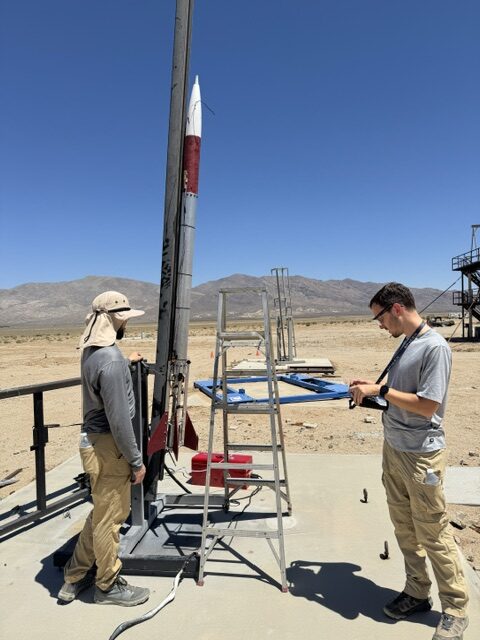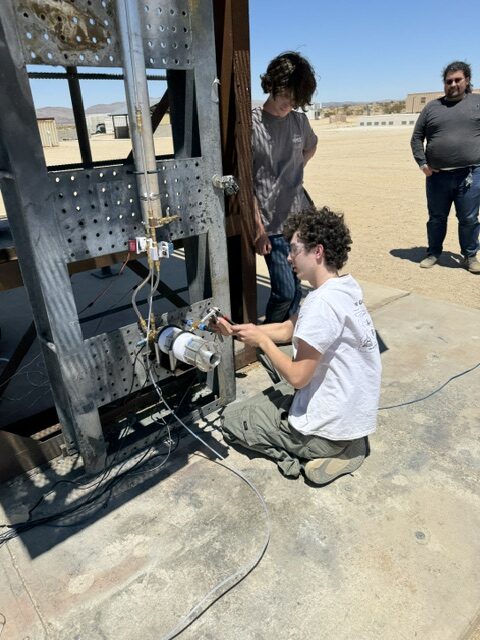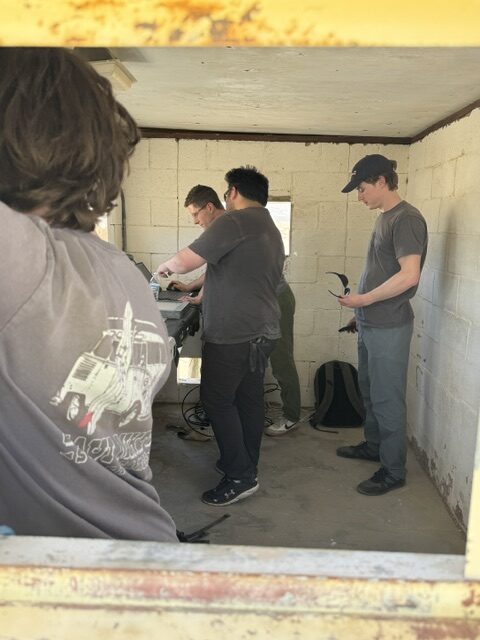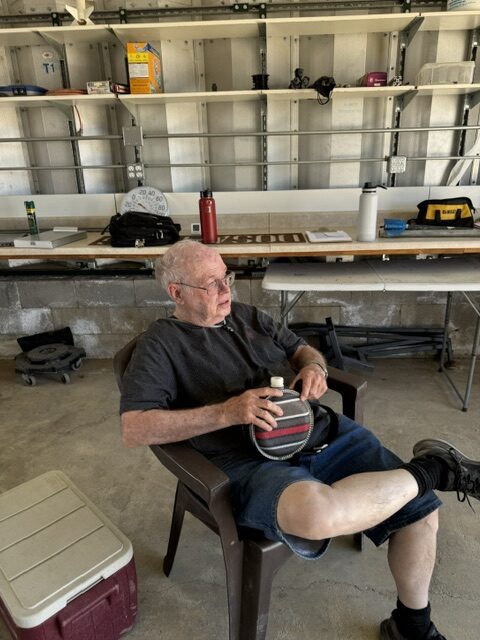Revised: September 27, 2025
The Reaction Research Society (RRS) is pleased to announce a recurring annual competition for university project teams to compete for a prize awarded for the longest steady-state impulse duration to date of a regeneratively cooled bi-propellant liquid propellant rocket engine in static fire at the RRS MTA under the guidelines given in this document.
All rules are explained below. This document shall represent the entirety of the rule set. For questions, contact the RRS president or the Regen Engine Prize committee chairman. The committee chairman shall be appointed by the RRS executive council from the committee membership and serve at their pleasure. The RRS Vice-President shall oversee the committee as the executive council’s lone representative and act with their authority.
Rules are subject to change solely by the RRS and updates shall be provided on our website, RRS.ORG, whenever they arise. The newest release date shall replace and void all prior copies.
In event of any conflict with the rules set here, all federal, state and local laws shall take precedence, following this the RRS Constitution and by-laws shall take precedence. If any part or provision of this document can not be enforced, the remaining terms remain enforceable even if one or more provisions are found to be invalid or unenforceable. Participant responsibilities can not be reassigned.
- Engines shall be designed and operated with liquid-phase propellants which includes cryogenic and pressurized liquids. Only bi-propellant engines are permitted.
- Engines shall be safely tested in static fire conditions at the RRS MTA. Only testing conducted at the RRS MTA during the annual competition period will be considered for the prize. All valid attempts to claim the prize must be declared in advance of the firing.
- This will be a recurring annual competition unless further notice is given by the RRS. The annual competition period will begin September 15 of each calendar year and end on June 15th of the next calendar year. The RRS shall determine how long the competition will continue and may terminate this competition at any time. A prize winner, if any, shall be announced no earlier than July 31st after that competition year closes. Announcements shall be made on the RRS.ORG website.
- The RRS executive council shall appoint a minimum of five but no more than seven persons to the committee charged with the task of judging this competition, verifying compliance with the rules, and determining which team, if any, will be awarded the prize in accordance with the rules herein. One person shall serve as the committee chairman. All communications shall be made through the committee chairman. Committee members shall be technically proficient in liquid rocket engines and be neutral observers. Committee members shall not have any influence over or be any part of any university team.
- A minimum of two committee members (or their assigned delegate) shall be present for any valid hot-fire attempt for the competition prize. Delegation of judging duties are the individual responsibility of the committee members and once accepted by the delegate, any delegations of their duties and authority shall be transmitted by email or in writing to the RRS president well in advance of the competition event.
- University teams are encouraged to ask questions of the committee at any time although questions in advance of firing will likely be more useful. The committee’s decisions are final, binding and not subject to repeal by the RRS.
- RRS policy on teams getting a free day in advance for only setup operations and free day subsequent to firing for striking and closeout activities is still permitted. No hot-fire activities or any activities requiring the presence of a pyro-op (by the pyro-op’s decision) are permitted during these free days. All scheduling and use of the RRS MTA is governed by the RRS president.
- All data and information regarding the engine testing must be recorded and submitted to the committee for their evaluation. Timeliness and accuracy of submittals are essential for the committee to validate claims made for the prize.
- Any missing information, misrepresentation, deception or lack of clarity in the submitted information provided to the committee may result in disqualification of the testing attempt or possibly barring the team from future competitions. Disqualification decisions are the sole responsibility of the committee.
- Engines shall be designed and constructed by the student team and not be derived from pre-existing commercial or surplus hardware. For all valid testing attempts for the prize, teams shall provide a full description of all material suppliers and machining service providers used to the RRS committee in advance of the firing.
- All teams shall provide a unique and distinctive name for their team and must provide an accurate listing of all participating members and a university faculty member to serve as the single point of contact and advisor for this project involved in the competition. The advisor must be a current university faculty member. All teams must submit their membership list and full point of contact information for their advisor to the RRS. All such information shall be provided to the RRS well in advance of any participation in this competition. University teams may assign leadership positions to coordinate activities associated with this competition or any operations with the RRS, but the advisor shall assume all responsibilities for their team.
- Only university-funded projects consisting solely of students and an advisor from that same specified university shall be allowed to participate in this competition.
- Sponsor-donated funds to university projects are acceptable provided all donors are declared, but for a team to be eligible for this competition they must represent a specific university. All teams must provide a full description of their budget and all sources of funding to the committee. All teams must provide sufficient financial information for the transfer of prize money or for the payment of fees or damages to the RRS.
- Competition is open only to teams comprised entirely of US Persons and all teams must remain in full compliance with US ITAR laws. US Persons are defined by being a natural person who is a lawful permanent resident as defined in 8 U.S.C 1101(a)(20) or who is a protected individual as defined by 8 U.S.C. 1324b(a)(3). All teams shall provide a full listing of all participants and provide the name and full contact information of their university advisor. The universities participating in this competition shall issue statements from their faculty advisor to the RRS certifying compliance to ITAR laws. Failure to provide such a statement in advance to the RRS or failure to comply with ITAR laws shall result in disqualification from this competition. Additional requirements for eligibility may also apply.
- All participants in this competition shall list the RRS and its assignees as listed insured by their university insurance policy. Consult the RRS executive council on these matters.
- All engines in this competition shall use a regenerative cooling scheme. The regenerative cooling flow path of the engine must cover the entire chamber length from injector face to throat line and to the nozzle exit plane. There is no specific requirement on the direction of the regenerative cooling path in engine designs, but the coolant path geometry and design must be fully described in the submittals to the committee. All engine designs must have a diverging nozzle with a minimum expansion ratio of 4.0. Local elevation of the RRS MTA is 2,300 feet above sea level.
- Ablative liners, graphite inserts or throats or the use of ceramic coatings are not permitted in engine designs in this competition.
- The use of propellant additives to reduce heat conduction at the chamber walls is banned from this competition. Propellant coking and similarly natural high-temperature breakdown of hydrocarbon fuels is an allowable exception.
- All regenerative cooling paths must be demonstrated not to leak both before and after the valid test attempt. This shall be confirmed by the RRS pyro-op in charge and the committee. Lack of leakage can be verified by a simple lock-up test of the engine article for a minimum period of 3 minutes and an applied gas pressure no less than 10 psig. Liquid fill and water submerged testing is permitted. All leak check operations are subject to governing MTA policy, pyro-op review and safety requirements.
- Transpiration cooling schemes from the chamber walls, throat, or nozzle are not permitted in engine designs in this competition. Only transpiration cooling of the injector face is permitted.
- Dump cooling schemes are not permitted in engine designs in this competition.
- Boundary layer coolant holes from the injector face are acceptable but must not exceed 5% of the total injector mass flow of that propellant as determined by analysis submitted and approved by the committee.
- All participants will conduct their qualifying hot fires exclusively at the Reaction Research Society’s Mojave Test Area (MTA). All scheduling at the MTA shall be done by the RRS president. Testing conducted outside of the RRS MTA or conducted outside of the annual competition period(s) shall not be considered for the competition.
- All participants shall be subject to society rules on safety throughout all operations at the MTA. A licensed CALFIRE Rockets Class 1 pyrotechnic operator is required to be present for each test attempt. The RRS president shall appoint the licensed pyrotechnic operator in charge for any operation at the MTA including each valid test attempt. All teams are required to comply with all orders from any pyro-op present but all shall defer to the orders of the pyro-op in charge.
- Longest steady-state duration shall be verified through submitted test data and information submitted by a competition team. Team demonstrating the longest steady-state duration of a valid engine design shall be the winner in each annual period of competition only if it exceeds the prior record by the minimum impulse amount. Prize will be awarded based on fully demonstrated and confirmed compliance with each of the following:
- Prize value is determined from an assumed rate of $0.30 USD for every 1.0 lbf-seconds of verified steady state impulse operation meeting all requirements as determined by the committee.
- Minimum qualification impulse for any prize in this competition shall be 3,000 lbf-seconds in the steady-state condition. This qualification impulse value will be always be subtracted away from the total measured impulse amount in a valid test.
- Prize money is based on the adjusted impulse value generated in test subtracting away this minimum qualifying impulse value.
- Example: a 1,000 lbf engine design that meets all requirements as confirmed in advance by the committee was fired at the MTA at an average thrust of 1,150 lbf for a qualifying steady-state duration of 25.3 seconds would have a total impulse of 29,095 lbf-sec, but will have an adjusted impulse of only 26,095 lbf-sec when subtracting away the qualification impulse value. If this is the winning entrant in that competition period, the prize awarded would be $7,828.50 USD in that annual competition period with any bonuses considered separately.
- Minimum chamber pressure throughout the entire steady-state period shall be 300 psig. Chamber pressure values shall be rounded down to the nearest whole number value. Once the minimum chamber pressure is first exceeded, any subsequent deviation below the 300 psig threshold for more than 0.25 seconds shall end the impulse bit for that entire firing.
- Minimum thrust value throughout the entire steady state period shall be 300 lbf. Thrust values shall be rounded down to the nearest whole number value. Once the minimum thrust value is first exceeded, any subsequent deviation below the 300 lbf threshold for more than 0.25 seconds shall end the impulse bit for that entire firing.
- Steady state conditions are defined as reaching and holding the declared nominal chamber pressure (psig) within +/~10% for the steady-state period.
- Minimum steady-state period shall be for a minimum of 5.0 seconds to qualify as a valid firing. Hot-fire durations shall be rounded down to the nearest tenth of a second.
- Each annual competition winner must exceed the prior record by a steady-state impulse value of at least 300 lbf-seconds. Otherwise, the prior record stands and no winner is awarded in that competition period.
- If no team is successful in surpassing the initial minimum impulse or surpasses previous record from the past annual competition periods by the minimum amount, no prize will be given for that competition period.
- Only one team will be awarded the prize in any competition period.
- The prize shall be no greater than $50,000 USD unless subject to bonuses described in this rule set only.
- Any bonuses may be awarded on top of the maximum prize money if the committee can confirm full compliance to the requirements for bonuses described in this rule set. Bonuses are awarded only to the annual competition winner if there is one.
- A $1,500 fixed bonus shall be awarded to the annual competition winner only if their engine design entirely avoids the use of 3-D printing or any additively manufactured parts as confirmed by the committee. This bonus is to reward those teams demonstrating more desirable skills in traditional manufacturing.
- As condition of claiming the prize, each winning team shall be required to fully describe their engine design with their hot-fire results in a 20-minute presentation to be given at the next annual RRS symposium. The purpose of this competition is to aid the development of the technology by sharing best practices.
- All qualifying test attempts for the annual competition prize shall measure thrust, chamber pressure and all propellant flow rates by data files submitted to and by techniques validated by the committee. All valid attempts to claim the prize will include the minimum amount of functioning instrumentation during the entire hot-fire period being evaluated. All teams shall declare their targeted performance parameters in advance of their testing attempt for valid comparison and qualification for the prize. Failure to meet any of these requirements shall invalidate the testing attempt.
- Instrumentation shall include a direct measurement of chamber pressure, engine thrust, and the propellant mass flow rates of all fuels and oxidizers.
- Measurements of fuel and oxidizer supply manifold pressures may be included but neither shall be a valid substitute for direct chamber pressure measurement.
- Microsoft Excel CSV files are the only allowed file format.
- Minimum data sampling resolution for all instrumentation shall be 0.1 seconds (10 Hz) with the exception of temperature measurements which shall be (0.25 Hz) if temperature measurements are used.
- Minimum accuracy of all pressure, thrust and mass flow rate measurements shall be better than 5% of declared nominal values as stated by the team prior to the test attempt. Error analysis and instrumentation accuracy information shall be supplied to and confirmed by the committee in advance of the testing.
- All participants including visitors and spectators shall have signed and submitted the indemnification waivers in advance of their arrival to the MTA on any day of operation. All participants including visitors and spectators shall fully comply with the instructions of the pyrotechnic operator in charge. The pyrotechnic operator in charge or the RRS reserves the right to limit the number of people in attendance at any particular MTA event.
- RRS shall approve all test plans, hardware, engine designs and operations well in advance of testing before allowing the test to be scheduled. A minimum of 4 weeks advance notice with all final materials submitted is recommended. RRS committee chairman at their sole discretion may refuse to review a participant’s firing attempt for lack of appropriate advance notice or time to conduct a sufficiently thorough review. Review of all testing equipment, test plans, procedures, safety features and equipment must be conducted by a Class 1 licensed pyro-op or an expert appointed by the RRS president.
- The pyrotechnic operator in charge has full authority and sole discretion to stop any operation, eject any person from the MTA or disqualify any team for any reason. All participants, attendees, visitors and spectators shall fully and immediately comply with all RRS appointed pyrotechnic operator instructions at all times.
- All resources used in this competition shall be coordinated and approved by the RRS president. The RRS is not obligated to provide any financial or material support of any kind to any team in this competition.
- All hot-fire attempts for this competition shall be subject to a minimum daily fee of $500 USD paid to the RRS within 30 calendar days of the test attempt. This is amount may not be lowered by the president or by any exception to RRS MTA policy.
- Universities may have multiple teams in the competition but each team shall be required to pay their own $500 USD minimum daily fee for that specific team.
- The current RRS standard fee policy shall apply to any operations outside of this competition.
- Failure to pay fees can result in disqualification or exclusion from future competition of the university. Fees are due to the RRS regardless of testing outcomes.
- Fees paid are not refundable, but attempts may be rescheduled with sufficient advance notice at the sole discretion of the RRS president.
- A free day in advance of testing for setup is permitted. No hot-fire, propellant transfer, attended leak checks or any activities requiring pyro-op supervision may be conducted.
- A free day after the last day of testing for striking and clean-up is permitted. No hot-fire, propellant transfer, attended leak checks or any activities requiring pyro-op supervision may be conducted.
- All teams shall be responsible for providing adequate and suitable fire suppression measures for the protection of RRS assets.
- All teams shall be responsible for trash disposal and appropriate waste management from all activities their team conducts at the RRS MTA. All teams shall be responsible for any damages incurred through the use of RRS MTA assets including but not limited to its restroom, container storage areas, electrical and power systems, and any environmental damage at the RRS MTA.
- All teams shall be responsible for the repair of damage to RRS assets sustained in events related to testing or paying for the costs of repairs as determined by the RRS. Damages to the RRS MTA facility or to any material items in the RRS possession shall be paid to the RRS by the university team. The RRS executive council shall be the point of contact for any such matters.
- All teams shall make safety their highest priority. All teams shall be responsible for designing safe and reliable pressure relief and venting systems, propellant filling and draining operations, prevention of mechanical, electrical and cryogenic hazards including exposure, fire and trapped fluid volumes, and incorporate adequate spill and contamination prevention and mitigation measures. All systems including but not limited to instrumentation, remote actuation, ignition, propellant and pressurization management shall be fully described for a full review by the RRS and the pyrotechnic operator in charge prior well in advance of any testing day.
- Changes to the designs after review are not permitted without subsequent review and approval by the RRS and pyrotechnic operator in charge.
- Teams are strongly encouraged to consult with the RRS in all phases of their design and development processes including the early conceptual periods.
- All teams shall abide by the stored energy limitations (19,305 Joules) for all attended operations at the RRS MTA. Otherwise, only remotely controlled operations are permitted. All teams shall fully and immediately comply with the instructions given by the pyrotechnic operator in charge as appointed by the RRS president.
- All teams shall abide by the flaring stack rules on the venting of volatile fuels as imposed by RRS MTA policies.
- The wearing and proper use of suitable personnel protective equipment by any persons involved with operations at the RRS MTA is mandatory and shall be the sole responsibility of every individual.
- All teams participating in this competition are required to specifically mention the “Reaction Research Society” in their related public announcements or social media postings. Contact the RRS secretary and vice-president for details.
For any questions regarding this competition or its rules, contact the RRS vice president or the RRS director of research. Questions shall be relayed from the executive council to the committee for their consideration. Please use the official RRS emails as individual officers are elected to annual terms and offices may change ownership in each calendar year.
Other important points of contact include:
Updates and new releases on this competition will be announced by postings on the Reaction Research Society website, RRS.ORG
For US Mail correspondence, write to:
Reaction Research Society
8821 Aviation Blvd.
P.O. Box 90933
Los Angeles, CA, 90009-0933
——————————————







